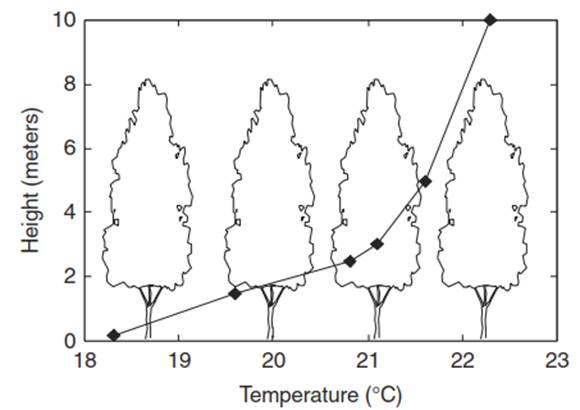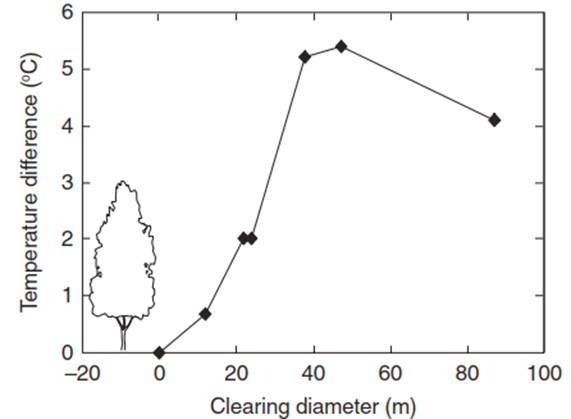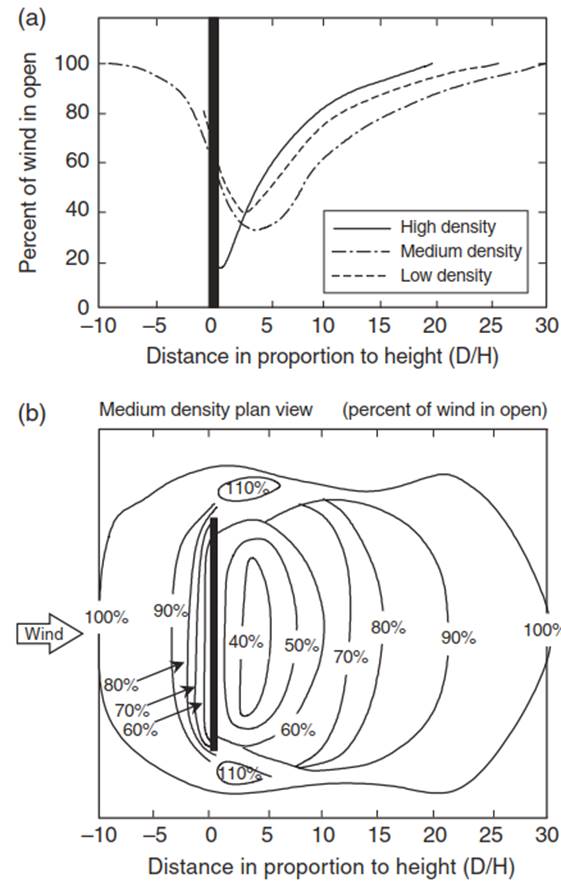Forest vs. Clearing Microclimates: Temperature Differences and Windbreak Effects Explained
The effect of vegetation on microclimates is seen by contrasting forested and open locations (Kittredge 1948; Geiger 1965). In general, daytime air temperature during summer is cooler in a forest than above canopy or in clearings. For example, one study found daytime air temperature above the canopy was greater than 22°C while air near the forest floor was 4°C cooler (Figure 6.18). In part, this is because the foliage in the forest canopy absorbs solar radiation so that there is little net radiation to heat the forest floor.

Fig. 6.18. Profi le of daily average air temperature above and within a forest canopy. Data from Geiger (1965, p. 321)
During daytime under periods of strong solar heating, air temperature in a forest is generally a few degrees lower than in adjacent clearings. Many factors such as the orientation of the forest edge, the height of trees, their leaf area, and prevailing winds influence the microclimates of a clearing. The size of a clearing relative to the height of surrounding trees is one critical factor. Figure 6.19 shows that midday air temperature measured at the center of a clearing is much higher than that measured in the surrounding forest. This temperature excess increases with clearing size. This is due to less shading by surrounding trees as the clearing increases in size. With a larger clearing size, however, radiation heating is less important because winds effectively carry heat away from the surface, and the temperature excess decreases.

Fig. 6.19. Difference in midday air temperature measured in a clearing and in a forest in relation to clearing size. Data from Geiger (1965, p. 352)
At night, clearings can be several degrees cooler than within forests because the dense forest foliage blocks the loss of longwave radiation from the surface. Net radiation is an important determinant of nighttime surface air temperature. During night, net radiation is the difference between atmospheric longwave radiation impinging on the surface and longwave radiation emitted by the surface. The surrounding trees obscure a portion of the sky, blocking some of the atmospheric longwave radiation. For a circular clearing of diameter D surrounded by trees of height H, the portion of the sky seen at the center of the clearing is (Oke 1987, p. 353):

where β is the angle formed between the center of the clearing and treetop (β = tan-12H / D). The remainder (1 - ψsky) is the terrain view factor. The total longwave radiation incident at the center of the clearing is the sum of that from the sky ( Lsky) and that from the surrounding trees (Lveg). The incoming longwave radiation is:

As the diameter of a clearing increases in size, a greater fraction of the longwave radiation comes from the sky and less comes from the surrounding trees. Since atmospheric radiation is considerably less than terrestrial radiation at night, there is less energy at the surface as the clearing size increases (Figure 6.20). Hence, one would expect smaller clearings to be warmer than larger clearings at night.

The presence of trees can also alter local winds. Patches of trees arranged closely together generally decrease wind to a distance of 20-30 times their height. This windbreak, or shelter- belt, effect has been widely used in rural settings to reduce winds blowing across open farmlands, thereby reducing erosion of soil and heat loss from isolated buildings (Oke 1987). Figure 6.21 illustrates the general aspects of windbreaks. The greatest reduction in wind occurs within a distance that is less than five times tree height, where winds decrease to 20-40 percent of those in open areas. The penetrability of barriers greatly affects wind reduction. A dense barrier has the largest reduction in wind speed, but the abrupt blockage of wind produces strong turbulence downwind so that the shelter effect is limited to only a short distance.

Fig. 6.21. Effects of trees on wind. the thick solid line represents a windbreak. Distance is measured upwind and downwind of the windbreak as a proportion of tree height. (a) Wind speed in relation to distance for low, medium, and high density vegetation. (b) Spatial pattern of wind speed around a medium density windbreak. adapted from Oke (1987, p. 244, p. 245)
The shelter effect is also small in sparse vegetation, where the winds readily penetrate the barrier. In contrast, the shelter effect extends further downwind in medium density windbreaks. Phenology influences the shelter effect. Winds are generally 20-30 percent lower when deciduous trees are in leaf than when leaves are off the trees (Landsberg 1981, p. 130).
References: Bryson, R. A., and Hare, F. K. (1974). Climates of North America. World Survey of Climatology, vol. 11. Amsterdam: Elsevier.
Finch, V. C., Trewartha, G. T., Robinson, A. H., and Hammond, E. H. (1957). Elements of Geography: Physical and Cultural, 4th ed. New York: McGraw-Hill.
Geiger, R. (1965). The Climate Near the Ground. Cambridge, Massachusetts: Harvard University Press.
Griffiths, J. F. (1972). Climates of Africa. World Survey of Climatology, vol. 10. Amsterdam: Elsevier.
Hocevar, A., and Martsolf, J. D. (1971). Temperature distribution under radiation frost conditions in a central Pennsylvania valley. Agricultural Meteorology, 8, 371-383.
Kittredge, J. (1948). Forest Influences: the Effects of Woody Vegetation on Climate, Water, and Soil, with Applications to the Conservation of Water and the Control of Floods and Erosion. New York: McGraw-Hill.
Landsberg, H. E. (1981). The Urban Climate. New York: Academic Press.
Date added: 2025-05-15; views: 276;
